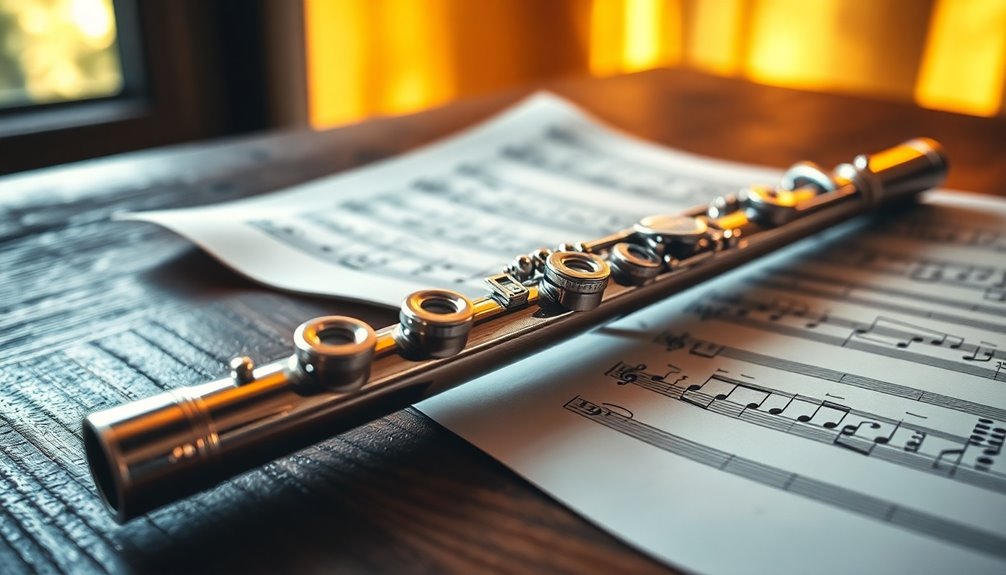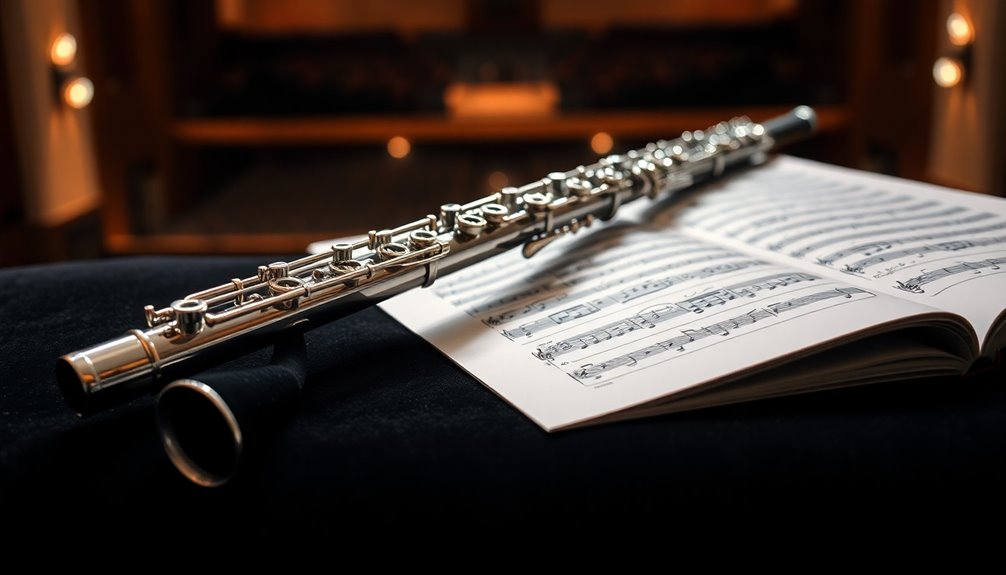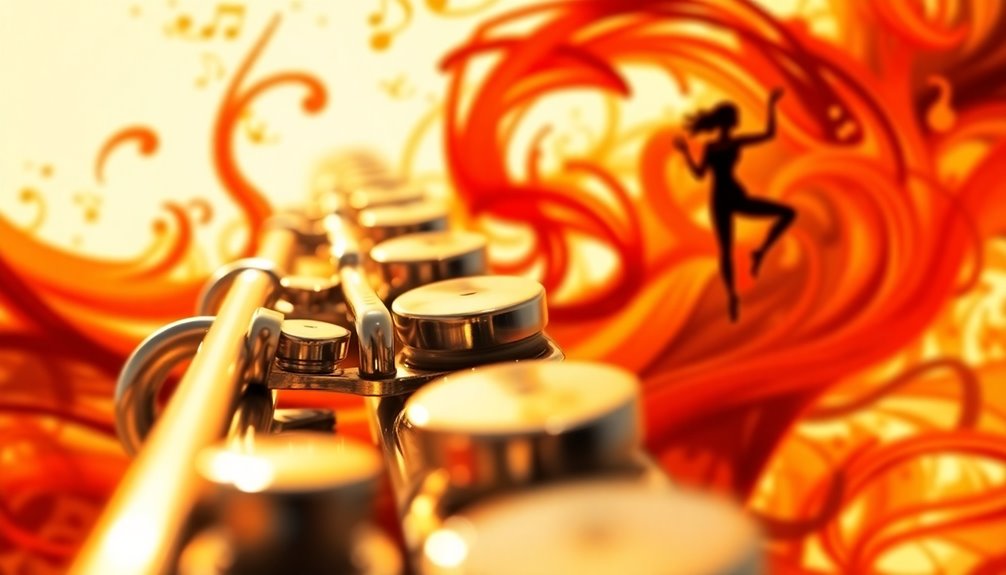If you're looking to expand your flute repertoire, consider modern compositions that showcase the instrument's versatility and emotional range. Works like André Jolivet's "Cinq Incantations" and Jacques Ibert's Flute Concerto offer innovative techniques and rich textures. Pierre Sancan's "Sonatine" excels in blending melody with intricate rhythms, while Jennifer Higdon's "Dances of Earth and Fire" invites dynamic storytelling. Claude Debussy's "Syrinx" captures the ethereal essence of impressionism. Each piece brings unique challenges and profound expression. With so many enchanting works available, you're sure to uncover hidden gems that resonate deeply.
Key Takeaways
- Cinq Incantations by André Jolivet explores the flute's expressive potential with ancient rituals and extended techniques for a mystical atmosphere.
- Dances of Earth and Fire by Jennifer Higdon features intricate rhythms and dynamic variety, intertwining narratives with nature's essence.
- Sonatine by Pierre Sancan blends lyrical melodies and intricate rhythms, showcasing distinct flute techniques across its three movements.
- Debussy's "Syrinx" transforms the flute into an expressive voice, utilizing flutter-tonguing and irregular rhythms to evoke nature and mythology.
- Takemitsu's "Cinq Préludes" challenges traditional performance through extended techniques, mixing Eastern and Western influences for innovative expression.
"Cinq Incantations" by André Jolivet

In the domain of modern flute compositions, "Cinq Incantations" by André Jolivet stands out as a fascinating exploration of the instrument's expressive potential. You'll discover how Jolivet's influences, particularly from ancient rituals and Eastern music traditions, shape this work's unique sound world. It's not just about notes; it's about invoking deep emotional responses through contemporary techniques that elevate the flute from mere instrument to a powerful voice.
Each of the five movements invites you into a different sonic landscape, utilizing extended techniques like flutter-tonguing and multiphonics. These aren't just gimmicks; they're integral to creating the mystical atmosphere Jolivet intended. You'll find yourself captivated by how he merges traditional melodies with avant-garde elements, allowing the flute to convey a wide range of feelings—from the serene to the frenetic.
As you listen, pay attention to the rhythmic complexity and dynamic contrasts that Jolivet employs. This adds layers of depth, encouraging you to engage with the music on multiple levels. The use of silence and space is particularly striking, making you aware of what's unsaid, enhancing the overall mystical quality of the piece.
"Cinq Incantations" isn't just a technical showcase; it's a spiritual journey that resonates with anyone seeking a deeper connection to music. By embracing Jolivet's innovative approach, you'll gain a profound appreciation for the flute's capabilities and the rich tapestry of modern composition. Notably, his integration of extended techniques in this work reflects a broader trend in contemporary flute music, showcasing the instrument's versatility.
"Flute Concerto" by Jacques Ibert

Engaging audiences since its premiere, Jacques Ibert's "Flute Concerto" showcases the instrument's versatility and charm through a brilliant interplay of melody and rhythm. This composition, written in 1934 during a time of artistic exploration, epitomizes Ibert's style, blending lyrical passages with sharp, intricate flute techniques.
The historical context of the piece reflects a shift in musical language, moving towards more expressive forms.
As you explore the "Flute Concerto," consider these key elements that highlight its brilliance:
- Composition Structure: The concerto consists of three distinct movements, each contributing to a narrative that captures the listener's imagination.
- Performance Challenges: Flutists often face technical hurdles, from rapid passages to nuanced dynamics, demanding both precision and emotional depth.
- Orchestra Dynamics: Ibert masterfully integrates the flute with the orchestra, ensuring a vibrant dialogue that enhances the emotional impact of the work.
- Reception History: Since its debut, the concerto has received acclaim for its innovation, establishing itself as a staple in the flute repertoire. Additionally, the piece requires flutists to demonstrate their skills in advanced flute techniques, making it a true test of artistry and technical proficiency.
"Sonatine" by Pierre Sancan

Pierre Sancan's "Sonatine," composed in 1946, presents an enchanting exploration of the flute's expressive capabilities while embracing a modern harmonic language. As you investigate this piece, you'll discover how Sancan's style uniquely intertwines lyrical melodies with intricate rhythms, creating a fascinating dialogue between the flute and piano.
The work unfolds in three movements, each showcasing distinct flute techniques that challenge and inspire players.
In the first movement, you'll encounter a delicate balance between agility and expressiveness. Sancan employs rapid passages that require precise articulation, while also allowing for moments of lyrical phrasing that invite emotional depth. As you navigate these contrasting elements, you'll appreciate how Sancan encourages you to explore the full spectrum of the flute's tonal palette.
The second movement introduces a whimsical character, filled with playful interactions that highlight the flute's agility. Here, you'll engage with flutter-tonguing and other extended techniques, pushing your technical limits while maintaining the piece's charm. This movement serves as a proof of Sancan's ability to blend innovation with accessibility.
Finally, the third movement brings a vibrant conclusion, filled with rhythmic drive and exuberance. You'll feel a sense of accomplishment as you master the rapid-fire passages, embodying Sancan's celebratory spirit. Additionally, mastering articulation techniques is essential for effectively conveying the emotions present in this dynamic composition.
"Dances of Earth and Fire" by Jennifer Higdon

Often regarded as a vibrant addition to the contemporary flute repertoire, Jennifer Higdon's "Dances of Earth and Fire" captivates with its vivid imagery and dynamic interplay of sound. This piece invites you to explore the depths of flute techniques while reflecting on the elemental themes of earth and fire.
Higdon's work is a masterclass in showcasing how contemporary influences can transform traditional soundscapes into something fresh and compelling.
As you immerse yourself in this composition, consider the following aspects that highlight its brilliance:
- Rhythmic Complexity: The intricate rhythms challenge flutists, pushing their technical abilities to new heights while maintaining a sense of fluidity.
- Expressive Range: Higdon employs a wide array of dynamics, from delicate whispers to powerful crescendos, allowing performers to convey a rich emotional landscape.
- Textural Variety: The use of extended techniques, such as flutter-tonguing and harmonics, creates layers that enhance the overall auditory experience.
- Thematic Exploration: Each movement reflects a unique narrative, intertwining the essence of nature with the expressive capabilities of the flute.
- Technical Proficiency: Mastering the intricate passages in this piece can significantly improve finger dexterity, which is essential for achieving precision in performance.
"Concerto for Flute" by Wolfgang Amadeus Mozart

The "Concerto for Flute" by Wolfgang Amadeus Mozart stands as a cornerstone of the classical flute repertoire, showcasing the instrument's lyrical beauty and technical prowess. When you immerse yourself in this piece, you can feel Mozart's influence resonate throughout the movements, making it not just a showcase for the flute but a dialogue between the soloist and the orchestra.
You'll notice how Mozart masterfully employs various flute techniques, from rapid passages that demand precision to expressive melodies that invite emotional exploration. The first movement bursts forth with vibrant energy, where the flute's agility is on full display, compelling you to marvel at its virtuosic demands.
As the piece unfolds, the second movement provides a moment of introspection, revealing the flute's softer, more nuanced qualities. You can almost hear the conversation between the flute and the orchestra, each responding to the other in an intricate dance.
The final movement brings back the lively spirit, encouraging a joyful, spirited exchange that leaves you breathless. This concerto not only highlights the technical capabilities of the flute but also reflects the heart of the Classical era's charm.
In exploring Mozart's "Concerto for Flute," you're not only engaging with a pivotal work in flute literature but also connecting with a timeless legacy that continues to inspire flutists and audiences alike. Playing classical flute solos enhances technical skills and musicality through diverse repertoire, building confidence through performance preparation and execution.
It's a piece that invites you to not just listen but to feel, making it essential for anyone passionate about flute music.
"Sonata for Flute and Piano" by Francis Poulenc

Following the classical elegance of Mozart, Francis Poulenc's "Sonata for Flute and Piano" presents a mesmerizing contrast that embraces the 20th-century spirit. This piece reflects Poulenc's influences, including jazz and French folk music, creating an atmosphere that's both lively and introspective.
You'll find that the sonata showcases innovative flute techniques that challenge and inspire flutists to explore their expressive capabilities.
Here are four key aspects that make this sonata a must-explore:
- Melodic Interplay: The seamless dialogue between flute and piano highlights the unique characteristics of both instruments. You'll hear how the flute dances gracefully, often leading the conversation, while the piano provides rich harmonic support.
- Rhythmic Diversity: Poulenc employs a variety of rhythms, from playful to contemplative. This rhythmic complexity invites you to engage with the music on a deeper level, feeling the pulse in your own body.
- Emotional Range: The sonata captures a wide spectrum of emotions, from joy to melancholy. Each movement tells a story, allowing you to connect with the music personally.
- Flute Techniques: Poulenc explores extended flute techniques, like flutter-tonguing and harmonics, pushing the boundaries of traditional playing. These techniques not only showcase the instrument's versatility but also invite you to experiment and grow as a musician.
Additionally, engaging with this sonata can significantly enhance your musical exploration, fostering a deeper understanding of diverse repertoire.
In "Sonata for Flute and Piano," Poulenc creates a world where you can belong, celebrating both the past and the innovative spirit of the present.
"Syrinx" by Claude Debussy

When you explore Claude Debussy's "Syrinx," you're stepping into a world of impressionistic sound that evokes the essence of nature and mythology. Composed in 1927 for a theatrical play, this solo flute piece showcases Debussy's influence on the evolution of modern music, particularly in how he transformed the flute into an expressive voice.
As you listen, you'll notice the various flute techniques Debussy employs, such as flutter tonguing and breath effects, which create an ethereal atmosphere. These techniques help convey the character of Pan, the Greek god of nature, and immerse you in the lush landscape of his world.
Debussy's use of irregular rhythms and unexpected phrasing invites you to feel rather than just hear, pulling you into a deeply emotional experience.
"Syrinx" is more than just a technical showcase; it's a narrative told through sound. The piece's structure, with its flowing melodic lines intertwined with moments of silence, reflects the tension and longing inherent in the myth of Pan and Syrinx.
As you engage with this composition, you'll find yourself exploring themes of desire and transformation, connecting deeply with its timeless essence. Additionally, the piece exemplifies the importance of structured progressions in developing flute playing skills, as it challenges performers to interpret its emotional depth.
Debussy's influence remains evident in contemporary flute repertoire, inspiring countless composers to push boundaries.
"Aubade" by André Jolivet

Emerging from the impressionistic shadows of Debussy's "Syrinx," André Jolivet's "Aubade" takes the solo flute into new domains of expression and complexity. This piece captures the essence of an aubade—a dawn serenade—imbuing it with rich textures and dynamic contrasts.
Jolivet's influences are evident as he draws from both ancient traditions and contemporary techniques, creating a sound world that feels both timeless and innovative. Exploring extended techniques can further enhance your interpretation of this work, allowing you to engage with its innovative soundscapes.
When examining "Aubade," consider these four key elements that deepen your interpretation:
- Nature and Awakening: Jolivet reflects the beauty of morning, using rising motifs to symbolize the sun's ascent. You can almost hear the world stirring to life through the flute's voice.
- Rhythmic Complexity: The interplay of various rhythmic patterns showcases Jolivet's mastery. Pay attention to how these rhythms evoke a sense of urgency and tranquility simultaneously.
- Emotional Landscape: Each phrase conveys a different emotion, from joy to introspection. Engage with these emotional shifts to connect more deeply with the music.
- Extended Techniques: Jolivet utilizes flutter-tonguing and harmonics, expanding the flute's expressive capabilities. Experimenting with these techniques can reveal new layers in your performance.
As you investigate "Aubade," you'll discover how Jolivet's unique approach invites you to explore the boundaries of flute music, fostering a sense of belonging in this vibrant musical community.
"Cinq Préludes" by Tōru Takemitsu

Tōru Takemitsu's "Cinq Préludes" offers five distinct musical explorations that challenge traditional notions of flute performance. Each prelude showcases Takemitsu's unique voice, drawing on his influences from both Eastern and Western musical traditions. You'll find his innovative approach to sound and silence profoundly engaging, as it reflects the essence of modern Japanese music.
As you immerse yourself in "Cinq Préludes," consider how each piece invites you to rethink the capabilities of the flute. Takemitsu employs extended techniques and unconventional rhythms, pushing boundaries while maintaining lyrical beauty. Here's a closer look at the preludes:
| Prelude Number | Key Characteristic | Emotional Tone |
|---|---|---|
| 1 | Whispering harmonics | Introspective |
| 2 | Rapid, contrasting motifs | Energetic |
| 3 | Fluid, melodic lines | Dreamy |
| 4 | Rhythmic complexities | Tension-filled |
In these pieces, you'll feel the interplay of silence and sound—a hallmark of Takemitsu's style. This exploration not only embodies his influences but also resonates with the broader landscape of modern Japanese music. By embracing techniques that encourage a dialogue between the performer and the audience, "Cinq Préludes" stands as a reflection of Takemitsu's artistry. Engaging with this work enriches your understanding of flute literature and connects you to a vibrant musical heritage. Furthermore, this collection reflects the influence of extended techniques, which enhance the expressive capabilities of the flute.
"Hymn and Fuguing Tune No. 9" by Charles Ives

Exploring the innovative soundscapes of modern flute compositions naturally leads us to Charles Ives' "Hymn and Fuguing Tune No. 9." This piece stands out for its fascinating juxtaposition of traditional hymn structures and the inventive, often dissonant harmonies that characterize Ives' style.
You'll find that Ives' innovation lies not just in his harmonic choices but also in the emotional depth conveyed through rhythmic complexity and tonal exploration.
As you investigate this work, consider these aspects:
- Hymn Structure: Ives reinterprets the familiar hymn format, inviting you to reflect on its cultural influence and spiritual resonance.
- Modern Harmonies: The piece showcases Ives' groundbreaking use of modern harmonies that challenge conventional listening.
- Ensemble Variations: Ives employs intricate ensemble variations, creating a rich tapestry of sound that reveals different layers with each listen.
- Emotional Depth: The combination of these elements evokes a profound emotional landscape, urging you to engage with the music on a personal level.
- Additionally, the work exemplifies the dynamic contrasts that are characteristic of contemporary compositions, enhancing its expressive quality.
Frequently Asked Questions
What Are the Key Themes in Modern Flute Compositions?
In modern flute compositions, you'll notice key themes like cultural influences and emotional expression.
These pieces often blend diverse musical traditions, reflecting the artist's background and experiences. You'll find that composers use the flute to convey deep feelings, from joy to sorrow, creating a powerful connection with listeners.
How Do Modern Composers Differ From Classical Flute Writers?
You might think modern composers just follow tradition, but they actually embrace experimental approaches that challenge the norm.
Unlike classical flute writers, who often stick to established forms, today's composers revel in stylistic innovations that push boundaries. They blend genres and incorporate technology, creating a fresh soundscape.
What Techniques Are Commonly Used in Contemporary Flute Music?
In contemporary flute music, you'll find a fascinating blend of techniques that elevate the instrument's expressive range.
Extended techniques, like flutter-tonguing and harmonics, challenge traditional boundaries, allowing for unique soundscapes.
Multiphonic playing, where multiple notes resonate simultaneously, adds depth and complexity.
These innovative approaches invite you to experience the flute in new ways, creating a sense of belonging within the vibrant community of modern composers and performers who embrace this evolving art form.
Are There Notable Flutists Who Specialize in Modern Compositions?
Did you know that only about 15% of flutists focus on modern repertoire? This highlights the importance of notable flutists who specialize in contemporary works, pushing boundaries and redefining the instrument.
Artists like Claire Chase and Marina Piccinini not only bring innovation to their performances but also inspire new generations.
How Can I Improve My Interpretation of Modern Flute Pieces?
To improve your interpretation of modern flute pieces, focus on diverse interpretative techniques that highlight emotional expression.
Experiment with dynamics, phrasing, and tempo to convey the piece's mood. Listen to various interpretations, noting how different artists approach the same work.
Engage with the music personally—what emotions does it evoke for you?
Conclusion
Exploring these ten modern flute compositions can deepen your appreciation for the instrument's versatility and expressive range. Did you know that over 80% of contemporary classical composers include the flute in their works? This statistic highlights the flute's significant role in today's music scene. Each piece on this list showcases unique techniques and styles, inviting you to experience the rich tapestry of sound that modern composers weave, ultimately enriching your musical journey.






